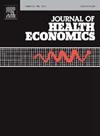Heterogeneous peer effects and gender-based interventions for teenage obesity
IF 3.6
2区 经济学
Q1 ECONOMICS
引用次数: 0
Abstract
This paper explores the role of gender heterogeneity in the social diffusion of obesity among adolescents and its policy implications. We propose a social interaction model which allows for gender-dependent heterogeneity in peer effects. Our empirical approach is consistent with the best response functions of a non-cooperative model where social interactions stem from the channel of pure spillover or pure conformity. We estimate the model using data on adolescent Body Mass Index and network-based interactions. Our approach allows us to account for network endogeneity. Our results show that peer effects are gender-dependent, and male students are particularly responsive to the weight of their female friends. According to simulations, reaching out to women results in an 8% increase in effectiveness in reducing overall BMI, based on the most conservative scenario. Thus, female-tailored interventions are likely to be more effective than a gender-neutral approach to fighting obesity in schools.
青少年肥胖的异质性同伴效应和基于性别的干预
本文探讨了性别异质性在青少年肥胖社会扩散中的作用及其政策意义。我们提出了一个社会互动模型,该模型允许性别依赖的同伴效应异质性。我们的实证方法与非合作模型的最佳反应函数是一致的,其中社会互动源于纯粹的溢出或纯粹的整合渠道。我们使用青少年身体质量指数和基于网络的互动数据来估计模型。我们的方法允许我们考虑网络内生性。我们的研究结果表明,同伴效应与性别有关,男学生对女性朋友的体重尤其敏感。根据模拟,在最保守的情况下,接触女性在降低整体BMI方面的有效性提高了8%。因此,针对女性的干预措施可能比性别中立的方法更有效地解决学校肥胖问题。
本文章由计算机程序翻译,如有差异,请以英文原文为准。
求助全文
约1分钟内获得全文
求助全文
来源期刊

Journal of Health Economics
医学-卫生保健
CiteScore
6.10
自引率
2.90%
发文量
96
审稿时长
49 days
期刊介绍:
This journal seeks articles related to the economics of health and medical care. Its scope will include the following topics:
Production and supply of health services;
Demand and utilization of health services;
Financing of health services;
Determinants of health, including investments in health and risky health behaviors;
Economic consequences of ill-health;
Behavioral models of demanders, suppliers and other health care agencies;
Evaluation of policy interventions that yield economic insights;
Efficiency and distributional aspects of health policy;
and such other topics as the Editors may deem appropriate.
 求助内容:
求助内容: 应助结果提醒方式:
应助结果提醒方式:


